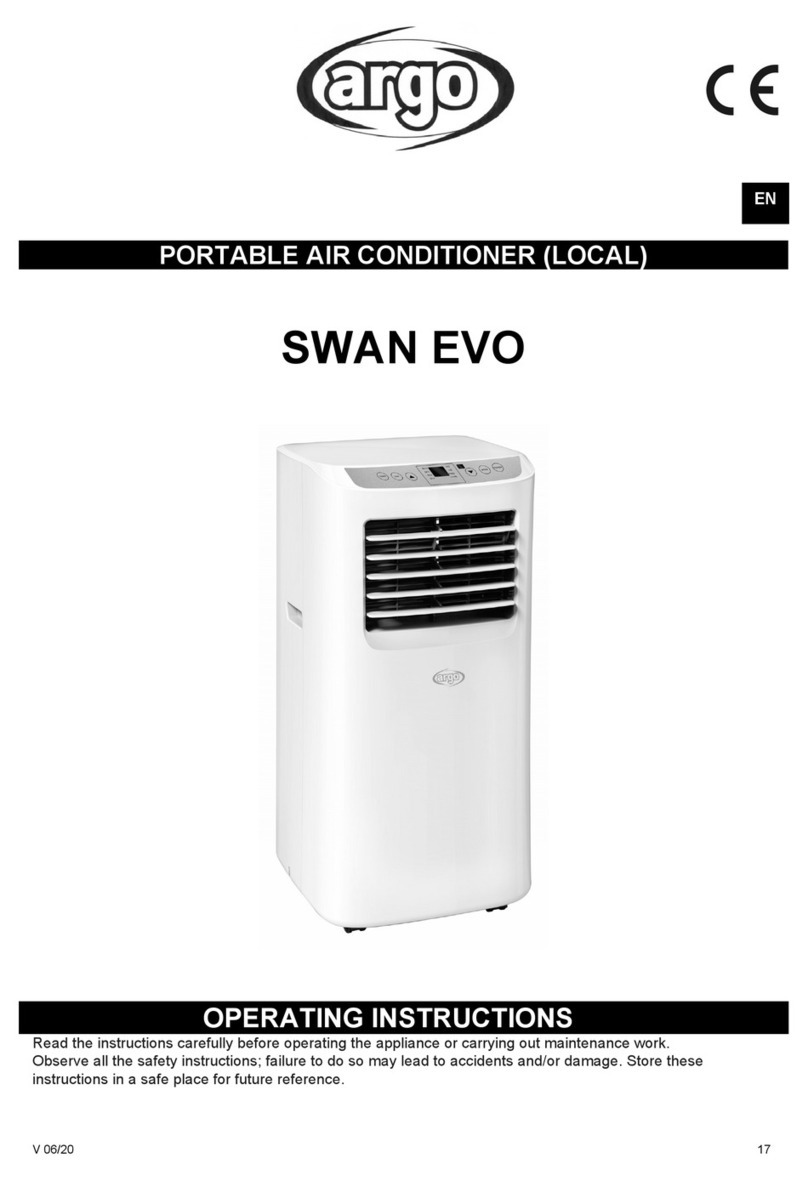Thermoscreens HP1000 DXE Guide

T9901085-1-3 UK Page 1 of 38
HP HEAT PUMP RANGE AIR CURTAINS
INSTALLATION, OPERATION & MAINTENANCE INSTRUCTIONS
For use with Mr Slim Outdoor Units
PLEASE READ THESE INSTRUCTIONS CAREFULLY BEFORE ATTEMPTING INSTALLATION
Thermoscreens Ltd
St. Mary’s Road Nuneaton
Warwickshire England
CV11 5AU
Email: [email protected]
Tel: +44 (0) 24 7638 4646
Fax: +44 (0) 24 7638 8578
www.thermoscreens.com
English
ErP
compliant

T9901085-1-3 UK Page 2 of 38
Thermoscreens / Mitsubishi Electric
Mr Slim HP Heat Pump Air Curtain System
CONTENTS
Page
Air Curtain System Schematics 3
Design Information 5
Unpacking the Air Curtain 8
INSTALLATION
Installation of the Air Curtain 10
Figure 2 – Dimensions of HP Air Curtain 11
Mitsubishi Electric Outdoor Unit 12
Refrigerant Pipework 12
To gain access inside the Air Curtain 13
Electrical Supply and Wiring to the Air Curtain 14
Wiring Diagram 1 (Defrost Cycle Auxiliary Heater disabled - as supplied) 16
Wiring Diagram 2 (Defrost Cycle Auxiliary Heater enabled on site) 17
Wiring of Air Curtain Fan Speed 18
Condensate Disposal System 18
COMMISSIONING
Air Curtain Checks 20
Dip Switch Settings and Air Temperature Sensor Position 21
Selecting the Fan Speeds of the Air Curtain 22
Starting the Heat Pump System 24
Weather Compensation Control or Discharge Air Temperature Control 24
Inlet Air Temperature Control or Room Air Temperature Control 27
Filter Dirty Indicator 28
Hand-over to End-User 30
USER INSTRUCTIONS
Weather Compensation Control or Discharge Air Temperature Control 31
Inlet Air Temperature Control or Room Air Temperature Control 32
SERVICING
Fortnightly Cleaning 33
Six Monthly Servicing 33
Fault Finding 36

T9901085-1-3 UK Page 3 of 38
Thermoscreens / Mitsubishi Electric
Mr Slim HP Heat Pump Air Curtain System
with Weather Compensation Control
or Discharge Air Temperature Control)
Air Curtain is supplied set-up to operate on either of these control modes
The Mr Slim HP Heat Pump Air Curtain System consists of :-
a Thermoscreens 'HP Air Curtain' fitted with a Mitsubishi Electric PAC-IF010B-E
Interface PCB, with dip switches set to be a PAC-IF020B-E *
a Mitsubishi Electric 'Mr Slim Outdoor Unit' +
a Mitsubishi Electric 'PAR-W21 MAA Remote Controller' for manual control by the
occupant of weather compensation control or discharge air temperature control +
a door switch to change fan speeds; higher speed when the door is open, lower speed
when the door is shut ^
a Thermoscreens ‘Remote 3-Speed Fan Switch’ (if end user requires this) *
* - supplied by Thermoscreens Ltd.
+- Mitsubishi Electric items supplied by the installer
^- supplied by the installer
Refrigeration pipework
Electrical cables
Control cables
BMS Control
Heat Pump
Air Curtain
Mitsubishi Electric
Mr Slim Outdoor Unit
S2, S3 communication
link with outdoor unit
Permanent electrical supply (from local switched spur)
1-phase for air curtain as supplied,
3-phase only if defrost cycle auxiliary heater is needed
(site change then required to air curtain)
(S1 is not used)
Permanent electrical supply
(from local switched spur)
Mitsubishi Electric
PAR-W21 MAA
Remote Controller
Optional
BMS Control
Interface Board
On/Off
Mode change
Weather compensation
control or Discharge air
temp. control
Mitsubishi error
BMS
Control
Remote
3-Speed Fan
Switch
(if end user
requires this) Door Switch to change fan speeds,
Door open - High; Door shut - Low
(industry standard fan speed control)

T9901085-1-3 UK Page 4 of 38
Thermoscreens / Mitsubishi Electric
Mr Slim HP Heat Pump Air Curtain System
with Inlet Air Temperature Control
or Room Air Temperature Control
Air Curtain is modified during commissioning to operate on these control modes
The Mr Slim HP Heat Pump Air Curtain System consists of :-
a Thermoscreens 'HP Air Curtain' fitted with a Mitsubishi Electric PAC-IF010B-E
Interface PCB *
a Mitsubishi Electric 'Mr Slim Outdoor Unit' +
a Mitsubishi Electric 'PAR-30MAA Remote Controller' for manual control by the
occupant of inlet air temperature control or room air temperature control +
a door switch to change fan speeds; higher speed when the door is open, lower speed
when the door is shut ^
a Thermoscreens ‘Remote 3-Speed Fan Switch’ (if end user requires this) *
* - supplied by Thermoscreens Ltd.
+- Mitsubishi Electric items supplied by the installer
^- supplied by the installer
Refrigeration pipework
Electrical cables
Control cables
BMS Control
Heat Pump
Air Curtain
Mitsubishi Electric
Mr Slim Outdoor Unit
Permanent electrical supply
(from local switched spur)
Optional
BMS Control
Interface Board
On/Off
Mode change
Capacity control
Temperature monitoring
Mitsubishi error
BMS
Control
Remote
3-Speed Fan
Switch
(if end user
requires this) Door Switch to change fan speeds,
Door open - High; Door shut - Low
(industry standard fan speed control)
Mitsubishi Electric
PAR-30MAA
Remote Controller
S2, S3 communication
link with outdoor unit
Permanent electrical supply (from local switched spur)
1-phase for air curtain as supplied,
3-phase only if defrost cycle auxiliary heater is needed
(site change then required to air curtain)
(S1 is not used)

T9901085-1-3 UK Page 5 of 38
DESIGN INFORMATION
AS SUPPLIED the air curtain operates on a 1 phase electrical supply (1L+N+E) from a local
switched spur which provides power for fans and controls. There is an integral defrost
cycle auxiliary heater located inside the air curtain but this is ‘disabled’ as supplied. If the
defrost cycle auxiliary heater is required the air curtain will then need a 3 phase electrical
supply (3L+N+E) from a local switched spur, instead of the 1 phase electrical supply, to
provide power for the heater as well which will need to be ‘enabled’ on site during
commissioning, see also notes on Page 6 and Section 'Installation - Electrical Supply and
Wiring to the Air Curtain', Page 14. There is also a communications link with the Mr Slim
outdoor unit via connections S2 and S3 (S1 is not used).
AS SUPPLIED the air curtain is set up for energy saving Weather Compensation Control
or Discharge Air Temperature Control and is used with a Mitsubishi Electric PAR-W21
MAA Remote Controller. The following functions are available:-
On/Off control of the Mitsubishi Electric heat pump system
Mode change between Heating mode and Fan only mode (Cooling mode not
available)
Energy saving weather compensation control or discharge air temperature control via
a set target temperature.
Signal for when the outdoor unit is in defrost mode so the defrost cycle auxiliary heater
(if enabled) can provide partial heat back-up during the few minutes of defrost.
Error signal for if the Mitsubishi Electric heat pump system has a problem
Weather Compensation Control (HEATING ECO): This looks at the outside air
temperature using an air sensor on the Mitsubishi Electric outdoor unit and automatically
adjusts the temperature of the air curtain discharge air in accordance with a heating curve.
It will select a warmer discharge air stream if it is cold outside and a cooler discharge air
stream if it is not so cold outside, as the discharge air does not need to be as warm. This
achieves significant energy and carbon savings because the heat pump compressor only
works at the capacity it needs to. Figure 1 shows a typical heating curve set up for weather
compensation control, temperature points 1, 2, 3 and 4 are selected during
commissioning.
Discharge Air Temperature Control (HEATING): The end user sets a target temperature
of, say 35°C, the air curtain then controls the temperature of the discharge air so it will stay
at 35°C even if the inlet air temperature changes.
0 155-5 20
Outdoor Air Temperature (°C)
40
20
30
Air Curtain
Discharge Air
Temperature (°C)
2
3
Figure 1
Weather Compensation Control
Typical heating curve
1
10
4
Heated Air Curtain
Ambient Air Curtain

T9901085-1-3 UK Page 6 of 38
The air curtain can also be set up on site during commissioning to operate under Inlet Air
Temperature Control or Room Air Temperature Control and is then used with a
Mitsubishi Electric PAR-30 MAA Remote Controller. The following functions are available:-
On/Off control of the Mitsubishi Electric heat pump system
Mode change between Heating mode and Fan only mode, with Cooling mode also
available if enabled during commissioning and with a condensate disposal system
Capacity control of the Mitsubishi Electric heat pump system
Temperature monitoring of the inlet air entering the heat pump air curtain, or the room
air temperature at the remote controller
Signal for when the outdoor unit is in defrost mode so the defrost cycle auxiliary heater
(if enabled) can provide partial heat back-up during the few minutes of defrost.
Error signal for if the Mitsubishi Electric heat pump system has a problem
Refer to a Mitsubishi Electric agent if the air curtain is to be controlled via a Building
Management System (BMS) or Centralised Controller.
It should be noted that during heating mode, if the outdoor unit goes into its defrost cycle
during cold weather, the air curtain fans will continue to operate to maintain the all-
important air stream across the doorway. It is this air stream, particularly towards the top of
the doorway, which is so effective at stopping buoyant warm air from inside the building
escaping to outside and wasting energy and also in reducing airborne contamination.
The temperature of the discharge air can be low during the 6 to 7 minute defrost cycle
period that may occur every few hours under particular outdoor weather conditions but this
has rarely become an issue with the end user and is really only a perceived problem.
There is a defrost cycle auxiliary heater fitted in the air curtain which is disabled when the
air curtain is delivered. If there are concerns for a particular installation this defrost cycle
auxiliary heater can be enabled during site commissioning and this will maintain the
discharge air at a higher temperature during the defrost cycle. A 3-phase electrical supply
is then required to power the air curtain.
Point of Information: If used, an auxiliary defrost heater may seem counter-productive for
a heat pump system. When put into context, however, the auxiliary heater fitted is of low
output for the size of the air curtain, it will just temper the discharge air and is only used for
a few minutes a day during a small period of the year. Tests at the Building Research
Establishment (BRE) test house on the heat pump air curtain system showed that even
with the auxiliary heater cutting in during defrost, as it has to during their EN14511
performance test, the annual seasonal COP was hardly affected.
Cooling is possible if the air curtain is modified during commissioning to operate under
Inlet Air Temperature Control or Room Air Temperature Control. It will not operate in
cooling if set-up to operate under Weather Compensation Control or Discharge Air
Temperature Control, which is how the air curtain is supplied.
The air curtain is supplied with its cooling mode disabled, although an integral condensate
drain tray is fitted inside the air curtain so it could be used in cooling mode during warm
weather, if so desired. This should be decided at the design stage as a condensate drain
system will need to be installed if cooling is required and extended to a suitable drain by
the installer. The condensate can be drained by gravity by connecting suitable condensate
hose onto the 15mm drain pipe on the condensate drain tray inside the air curtain. If a
gravity condensate drain is not visually suitable it will be necessary to remove condensate
using a condensate pump, supplied and fitted by the installer. The condensate pump can

T9901085-1-3 UK Page 7 of 38
be located inside the right hand end of the air curtain or in a remote location outside of the
unit if required. It must be of sufficient capacity, see Page 19, self priming and capable of
providing the appropriate suction head so the pump will lift condensate out of the air
curtain, particularly if it is in a remote location. There are two hole penetrations at the right
hand end of the air curtain for condensate pipework to pass through, see Figure 2, Page
11. Suitable condensate pumps are Peristaltic or Rotary Diaphragm type. We recommend
the Blue Diamond rotary diaphragm type with cooling signal sensor (drainStik)
manufactured by Charles Austen Pumps Ltd. (www.miniblue.co.uk).
If using a condensate pump it is recommended that it has the facility so it only operates
when the air curtain is in cooling mode by detection of water in the drain tray or by
detecting a cooling differential in the airflow. It should also have a pump overrun feature to
empty the drain tray as much as possible when the air curtain is switched off. It should
have an alarm system with appropriate sensor fitted in the drain tray that will give a volt-
free signal (closed circuit = alarm) and stop the air curtain cooling if the condensate drain
tray is in danger of flooding (air curtain fans will continue to operate). There is a fixing
bracket with 8mm diameter hole attached to the drain tray inside the air curtain so a
condensate sensor can be fixed in the tray by the installer. The hole can be enlarged, if
necessary, to suit the type of sensor used so it is located in the tray at the appropriate
position, see the manufacturer’s instructions that come with the condensate pump for
further information. A 230V AC, single phase electrical supply is provided inside the air
curtain to power a condensate pump and a condensate alarm connection is provided for
the condensate pump alarm circuit.
Warning: The air curtain condensate collection system is designed to remove condensate
with the air curtain operating in cooling mode during normal summer weather conditions in
countries with a temperate climate. In case of extreme weather conditions, drain tray
blockage or condensate pump failure, which can occur, it is vital that the design of the floor
beneath the air curtain and its surface is such that it will not become slippery or damaged if
it became wet. This is similar to the conditions that might be experienced with heavy
rainfall in at an open doorway or wet pedestrian foot traffic, so careful consideration must
be paid to the design of the floor and its surface finish.
If it is intended that the air curtain should not operate in cooling mode (which is how the air
curtain is supplied) and a condensate drain system is not fitted, it is still recommended that
the floor design and surface be as described above, in case cooling mode is used in the
future and also to cope with heavy rainfall or wet pedestrian foot traffic.
The air curtain is designed only for use with a Mitsubishi Electric Mr Slim Outdoor Unit for
use on R410A. The complete Thermoscreens air curtain / Mitsubishi Electric heat pump
system, including refrigerant pipework, wiring, controls, etc. must be installed only by an
approved Mitsubishi Electric refrigeration contractor.
Persons using the air curtain must be given adequate instruction and supervision
concerning the use of the appliance by a person responsible for their safety. The air
curtain is not intended for use by persons (including children) with reduced physical,
sensory or mental capabilities.
These instructions must be read in conjunction with the separate Mitsubishi Electric
instructions that come with the Mr Slim Outdoor Unit. All instructions should be kept by the
building facilities manager for future reference.

T9901085-1-3 UK Page 8 of 38
UNPACKING THE AIR CURTAIN
The following items are supplied and packaged within the air curtain box :-
If anything is missing or damaged please contact your place of purchase immediately.
There will also be a 'Mr Slim Outdoor Unit' and ‘Remote Controller’ (if required) supplied by
Mitsubishi Electric.
The Installer will also need to supply and install the following:-
Wall Brackets and Fixin
g
Bolts
for if air curtain is to be wall mounted
or
PAR-30 MAA Remote Controller
If
A
ir Curtain is to be manually controlled for
inlet air or room air temperature control,
also needed for commissioning
PAR-W21 MAA Remote Controller
If Air Curtain is to be manually controlled for
weather compensation control or discharge air
temp. control, also needed for commissioning
Remote 3-Speed Fan Switch
If remote fan speed control is required by the end use
r
NB Industry standard is to have High/Low fan speed control
via a door switch or single speed set at commissioning
HP Heat Pump Air Curtain
Please note, plastic end caps are supplied
loose to be fitted during installation

T9901085-1-3 UK Page 9 of 38
The installer may also need to supply and install the following optional items:-
The complete Thermoscreens air curtain / Mitsubishi Electric heat pump system, to provide a
heat pump air curtain over a doorway, including wiring, fridge pipework, etc. is to be installed
only by an approved Mitsubishi Electric refrigeration contractor.
IMPORTANT
This Heat Pump Air Curtain is intended only for use with a Mitsubishi Electric Mr Slim
Outdoor Unit, for use on R410A.
These instructions must be read in conjunction with the Mitsubishi Electric Mr Slim
Outdoor Unit instructions.
(All documentation supplied with each unit should be stored and kept for future reference.)
For your records:
Date of Purchase……………………………..
Place of Purchase…………………………….
Serial Number…………………………………
For warranty purposes proof of purchase is necessary so please keep a copy of your invoice.
Condensate Pump – self priming with
cooling mode detection, alarm
system and pump overrun
If
A
ir Curtain is to be operated in COOL mode
and gravity drain cannot be used – see text
on Page 6 & 7 for more information
Door Switch – for energy efficient,
noise friendly, fan speed control,
Door open – Higher fan speed
Door shut – Lower fan speed
Gives industry standard fan speed control
–
see
wiring diagrams on Pages 16 & 17 and text on
Pages 18 & 22 for more information
Example Switch only

T9901085-1-3 UK Page 10 of 38
Recommended
250mm min.
for pipework
INSTALLATION OF THE AIR CURTAIN
The air curtain is designed to be surface mounted inside a building and located
horizontally over a doorway. It must not be installed on the outside of the building,
or built into a cabinet or recessed in anyway.
Location
The air curtain must be mounted so the discharge grille is
located up to 3.2m maximum above floor level and as
close to the doorway as possible. It must be installed level
or condensate may leak out if used for cooling. It is
recommended to leave a gap of 250mm minimum above
the air curtain to allow for pipework brazing operations.
Beware of doorway top edges, structural beams, door
opening/closure devices, etc. which may interfere with the
air stream and affect the location of the unit.
Wall Fixing
Bolt all of the wall brackets supplied to the rear face of the
unit as shown in the adjacent picture using the M10 bolts
supplied. Suitable wall fixing bolts (not supplied) need to
be used to fix the brackets to the wall, taking into account
the type of wall and the weight of the unit*, see table:
Air Curtain Weight (kg)
HP1000 DXE 46
HP1500 DXE 67
HP2000 DXE 84
Step 1. Refer to Figure 2, Page 11 for mounting details
and drill the fixing points in the wall.
Step 2. Screw in the top wall bolts leaving a small gap between the head and the wall.
Lower the unit onto the bolts via the key-hole slots in the top of the wall brackets and then
screw in the bottom wall bolts.
Step 3. Ensure all fixing bolts are tightened and the air curtain is safely secured to the
wall.
Ceiling Suspension
M10 threaded inserts are provided in the top face of the
unit (see Figure 2, Page 11 for positions) so it can be
suspended on M10 threaded hanging rods (not provided).
All suspension points must be used. Ensure each of the
hanging rods is secured onto a suitable structure that can
support the weight of the unit (see table above)*. Screw
the hanging rods into the inserts by a minimum or 20mm
and fit locking nuts (not provided) to prevent the rod
rotating and coming away from the casing. Do not screw
the hanging rod too far in or it could interfere with internal
components.
*It is the sole responsibility of the installer to ensure that the building fixing locations and suspension system
used are suitable for the air curtain being installed.

T9901085-1-3 UK Page 11 of 38
1300
HP1000DXE 1825 2350
HP1500DXE HP2000DXE
A (mm)
605 1225 1793
-655 918
898 1398 1904
-699952
182 222 204
-570 875
442 333 299
253 267 258
359 359 334
80 45 80
B (mm)
C (mm)
D (mm)
E (mm)
F (mm)
G
H (mm)
I (mm)
J (mm)
K (mm)
L
M (mm)
58in. 58in. 78in.
12in. 58in.
12in.
Inserts for M10 drop rods
4 for 1m unit, 6 for 1.5m/2m units
Use all drop rod holes !
J
K
D
EE
45
225
20
45
50
200
340
25
15
306
100
Recommend
250 minimum
for pipes
AIR IN
AIR OUT
468
1.5m only
4545
105
A
B
I F
H
250
Gas Line
Refrigerant
Connection (G)
Electrical Supply and Mitsubishi
Control Wiring Inlets (M20)
Liquid Line
Refrigerant
Connection (L)
Gas Line Refrigerant Connection (G)
Liquid Line Refrigerant Connection (L)
20mm hole on top for pumped
condensate disposal (if cooling)
20mm hole for gravity or pumped
condensate disposal (if cooling)
MC
Additional (M20)
Wiring Inlets on top
FIGURE 2 – DIMENSIONS OF HP HEAT PUMP AIR CURTAIN

T9901085-1-3 UK Page 12 of 38
Mitsubishi Electric Outdoor Unit
The Mitsubishi Electric Mr Slim Outdoor Unit is selected to match its refrigerant heat
output to the size of the Air Curtain. See table below for size of outdoor unit to be used
together with performance data for the air curtain.
Air Curtain Mr Slim
Outdoor Unit
Air Curtain Parameters
Maximum
Heating
Output
(kW)
Maximum
Cooling
Output
(kW)
Maximum
Air Volume
Flow Rate
(m3/h)
Maximum
Noise
Level
dB(A) @3m
Effective
Width of
Airstream
(m)
HP1000 DXE PUHZ-RP71 8.3 7.4 1310 58 1.10
HP1500 DXE PUHZ-RP125 13.8 12.3 2070 58 1.63
HP2000 DXE PUHZ-RP140 15.9 14.2 2590 58 2.15
HP2000 DXE PUHZ-RP200* 21.0 18.7 2590 58 2.15
Outputs based on:- Indoor air temperature = 20ºC. Outdoor condition = 7/6 db/wb ºC for heating output,
35/27 db/wb ºC for cooling output.
Performance figures derived from independent testing by UK test houses BRE and BSRIA in accordance with
test standard EN14511. Noise testing carried out at Sound Research Laboratories to ISO3741 and BS4856-4.
See Table on Page 23 for more details of air volume flow rates and noise levels.
* Alternative larger outdoor unit will give enhanced heat output for difficult doorway situations - not
recommended, however, for weather compensation control or discharge air temperature control.
Refrigerant Pipework
This must be carried out before connection of any electrical and controls cables
and in accordance with the Instructions that come with the Mitsubishi Electric
Outdoor Unit. This work must only be undertaken by a Mitsubishi Electric
approved Contractor.
Contact Mitsubishi Electric for recommended pipework sizes, pipework lengths,
numbers of fittings, etc.
The installation must be carried out in accordance with the Mitsubishi Electric
Installation Manual that comes with the outdoor unit.
It is intended that refrigerant pipe connections to the air curtain are made using brazed
joints and these must be carried out in a professional and safe manner. If installation
pipe sizes for the discharge (gas) line and liquid line are different from the pipe
connection sizes on the air curtain (see Figure 2, Page 11) suitable pipe reducers must
be used for the connection. R410A refrigerant systems can operate at pressures up to
610 psi (c. 42 Bar). These brazed joints may well be located in a public area and a
weakness leading to an explosion could be extremely dangerous.
The air curtain with its coil is manufactured in accordance with the Pressure Equipment
Directive (PED) and the installation must be carried out to a good standard of
workmanship. Remove the protective plastic film on top of the air curtain before starting
work and protect the top surface of the air curtain. Use a heat sink on the copper pipes
during brazing to reduce the transfer of heat to the inside of the air curtain where
sensitive components are located.

T9901085-1-3 UK Page 13 of 38
access
p
anel
screw
To gain access inside the Air Curtain
To gain access for connection of the electrical supply, controls wiring
and to work on the unit during commissioning, remove the air inlet
grilles and the bottom access panel.
First remove the plastic end caps at each end of the unit, if already
fitted, by pulling off to the side (see picture).
Then remove each inlet grille in turn with its filter by unfastening
the quarter-turn Philips Head fastener at the bottom corner of the
grille. Use a Philips No.1 screwdriver to access the screw via the
elongated hole at the bottom corner of each grille and turn anti-
clockwise to remove (see picture).
To remove the bottom access panel unfasten the access panel
securing screws, one at each end, plus two in the centre
(HP1500 DXE and HP2000 DXE units) and slide the panel out
forwards (see picture).
Please note: All the panels of the air curtain are covered in a protective plastic film
which should now be removed.

T9901085-1-3 UK Page 14 of 38
Electrical Supply and Wiring to the Air Curtain
This must be carried out AFTER the connection of the refrigerant pipework. All
electrical wiring and connections MUST be carried out by a competent qualified
electrician in accordance with the latest edition of the IEE wiring regulations
and/or local statutory regulations. (see also Wiring Diagrams 1 & 2 on Page 16/17)
A local isolator having a contact separation of at least 3mm on all poles must be
fitted in the 1 phase electrical supply (1L + N + E) to the air curtain and located in
an accessible position adjacent to the unit.
Do not have a switch or isolator in the S2, S3 (Comms Link), use continuous wire.
If the defrost cycle auxiliary heater is to be used the air curtain then requires a 3
phase electrical supply (3L + N + E) to the air curtain instead of a 1 phase
electrical supply. A local isolator having a contact separation of at least 3mm on all
poles must be fitted in the 3 phase electrical supply and located in an accessible
position adjacent to the unit. The defrost cycle auxiliary heater will need to be
enabled during commissioning (see Section ‘Design Information’ – Page 5 and
Section ‘Commissioning’ Page 20).
The appliance must be connected using cables having an appropriate temperature
rating (heat resistant).
Ensure that the supply cables, circuit breakers and other electrical installation
equipment are correctly sized for the air curtain being installed. See Table below.
A 25mm size cable gland or conduit connector should be used for the Electrical
Supply into the air curtain. See Figure 2, Page 11 showing where the electrical
supply enters the unit.
This appliance must be Earthed.
Wire in accordance with 1) or 2) in the Table below:
Air Curtain
1) Unit as supplied - defrost cycle
auxiliary heater is disabled
(230V/1ph/50Hz electrical supply from
separate local isolator)
2) the defrost cycle auxiliary heater is
to be enabled during commissioning
(400V/3ph/50Hz electrical supply from
separate local isolator)
Rated Electrical
Power Input (kW) Rated Current (A) Rated Electrical
Power Input (kW) Rated Current per
phase (A)
HP1000 DXE 0.2 0.8 4.7 7.3
HP1500 DXE 0.3 1.2 7.8 12.1
HP2000 DXE 0.35 1.4 9.35 14.4
1) Unit as supplied – defrost cycle auxiliary heater is
disabled, see Wiring Diagram 1, Page 16
(230V/1ph/50Hz electrical supply from separate local
isolator)
Connect to terminals Earth, L1 and N with a 1-phase
electrical supply.
Connect terminals S2 and S3 from the outdoor unit to
terminals S2 and S3 on the air curtain – Communication
link between outdoor unit and the air curtain.
Connect a Mitsubishi Electric PAR-W21MAA or PAR-
30MAA Remote Controller to terminals 1 and 2 on the
air curtain.

T9901085-1-3 UK Page 15 of 38
2) If the defrost cycle auxiliary heater is to be enabled
during site commissioning
(400V/3ph/50Hz electrical supply from separate local
isolator), see Wiring Diagram 2, Page 17
Connect to terminals Earth, L1, L2, L3 and N with a 3-
phase electrical supply.
Connect terminals S2 and S3 from the outdoor unit to
terminals S2 and S3 on the air curtain – Communication
link between outdoor unit and the air curtain.
Connect a Mitsubishi Electric PAR-W21MAA or PAR-
30MAA Remote Controller to terminals 1 and 2 on the
air curtain.
If required the defrost cycle auxiliary heater can be
enabled by disconnecting the neutral wire (violet) from
the auxiliary terminal 14NO on the contactor inside the
air curtain. This wire is then connected onto terminal A2
on the contactor as shown in the adjacent picture (see
also Wiring Diagram 2 on Page 17).
Recommended wire sizes for electrical connections are as follows:
Electrical Connection Wire Size
1-phase electrical supply from separate local isolator 2.5mm
2
max. for access
3-phase electrical supply from separate local isolator - if the
defrost cycle auxiliary heater is to be enabled 2.5mm2max. for access
S2, S3 – communication link between outdoor unit and the
air curtain 1.5mm2
Mitsubishi Electric PAR-W21MAA or PAR-30MAA Remote
Controller (2-core cable) 0.75mm2
Door switch to change fan speeds as door opens and shuts
or Remote 3-Speed fan switch 0.75mm2
Refer to Mitsubishi Electric for electrical details of the Mr Slim Outdoor Unit.

T9901085-1-3 UK Page 16 of 38
TERMINAL
BLOCK
230v AC
RELAY
MITSUBISHI ELECTRIC
OUTDOOR UNIT
THERMOSCREENS HEAT PUMP AIR CURTAIN
L
L1 L2 L3 N
MAIN INTERFACE
BMS
CONTROL
FILTER
INDICATOR PCB
0
1
2
3
4
5
6
1~
0
2
3
4
5
6
1~
Fan motor 1
CONDENSATE ALARM
Closed Circuit = Alarm
(Compressor Stops)
BlackWhiteRed
IN1(2)
IN1(1)
IN2(2)
IN2(1) Red
Black
CN105
15
CNX1 CNX4 CNX5
Fan
Control
Heater
Control
Black
Yellow
Brown
MITSUBISHI ELECTRIC
INTERFACE PCB
PAC-IF010B-E (v.H48<)
S1 S2 S3
N
Pink
Blue
Green/Yellow
K1
Wire link connector must
be removed from CNS2
Orange
1
S3
L3
L2
L1
21
11
22
24
12
14
S1 S2 S3
NL
K1
A2
A1
14NO
13NO
DEFROST
CYCLE
AUXILIARY
HEATER
White
Thermistor (TH5) - Factory fitted
Thermistor (Liquid) - Factory fitted
White
S2
pcb track
A1A2
CONTACTOR
CONTACTOR
Orange
Brown
Grey
Black
Brown
RC
230v AC electrical power for condensate pump (if required)
Cooling
On
Fan motor 2
(2m unit only)
For Weather Compensation or
Discharge Control, PAR-W21:
SW1-3, SW3-7, ON
For Inlet Air or Room Control,
PAR-30: SW1-2, 1-3, ON
All other dips- OFF
Dip Switch Settings:-
AB
Black High
Low
Med
Fan
SITEWIRING
High
Low
Med
Fan
or wire in a Door-Switch:-
Door Open - Higher speed
Door Closed - Lower speed
MITSUBISHI ELECTRIC
PAR-W21MAA for
weather compensation,
or PAR-30MAA for inlet
air control
or wire in Thermoscreens 3-Speed Fan Switch
876
Carries
230v AC
54321
High
Low
Med
Fan
wire link for
Medium Speed
fitted as standard
Door-Switch
2A - AC3, 230v AC
1
2
PL
Yellow
Violet
Violet
Violet
Violet
L
Red
Black
N
Electrical Supply for
Outdoor Unit
230V/1ph/50Hz
or 400V/3ph/50Hz
Plug connected prevents
cooling with Inlet Air & Room
Air Control. Remove plug from
CNX5 if using Cooling Mode
Thermistor (Discharge Air or Inlet Air) - Factory fitted
TOC
TOC
Defrost Heater
Thermal Trip
(x2 on 2m unit)
Red
Red
N
FUSE
TERM.
T 5A
FUSE
Red
Yellow
Red
not used
Black
Red
The air curtain is delivered
with the Defrost Cycle
Auxiliary Heater disabled.
230V/1ph/50Hz Electrical Supply
HP1000DXE = 0.8A
HP1500DXE = 1.2A
HP2000DXE = 1.4A
Blue (Neutral)
Brown (High)
Grey
Violet
Orange
Red (Low)
Blue (Neutral)
Brown (High)
Grey
Violet
Orange
Red (Low)
Blue
WIRING DIAGRAM 1 – HP MR SLIM HEAT PUMP AIR CURTAIN (No Defrost Cycle Heater – unit as supplied)

T9901085-1-3 UK Page 17 of 38
TERMINAL
BLOCK
230v AC
RELAY
MITSUBISHI ELECTRIC
OUTDOOR UNIT
THERMOSCREENS HEAT PUMP AIR CURTAIN
L
L1 L2 L3 N
BMS
CONTROL
FILTER
INDICATOR PCB
The air curtain is delivered with the Defrost
Cycle Auxiliary Heater disabled but it can
be enabled during site commissioning if
required.
To enable the Defrost Cycle Auxiliary
Heater disconnect the Violet neutral wire
from auxiliary terminal 14NO and connect
this wire onto terminal A2.
0
1
2
3
4
5
6
1~
0
2
3
4
5
6
1~
Fan motor 1
CONDENSATE ALARM
Closed Circuit = Alarm
(Compressor Stops)
BlackWhiteRed
IN1(2)
IN1(1)
IN2(2)
IN2(1) Red
Black
CN105
15
CNX1 CNX4 CNX5
Fan
Control
Heater
Control
Black
Yellow
Brown
MITSUBISHI ELECTRIC
INTERFACE PCB
PAC-IF010B-E (v.H48<)
S1 S2 S3
N
Pink
Blue
1m unit 3 x 1.5kW = 4.5kW
1.5m unit 3 x 2.5kW = 7.5kW
2m unit 3 x 3.0kW = 9kW
Green/Yellow
K1
Wire link connector must
be removed from CNS2
Orange
1
S3
L3
L2
L1
21
11
22
24
12
14
S1 S2 S3
L3L2L1
K1
A2
A1
14NO
13NO
DEFROST
CYCLE
AUXILIARY
HEATER
White
Thermistor (TH5) - Factory fitted
Thermistor (Liquid) - Factory fitted
White
S2
pcb track
A1A2
CONTACTOR
CONTACTOR
Orange
Brown
Grey
Black
Brown
RC
230v AC electrical power for condensate pump (if required)
Cooling
On
Fan motor 2
(2m unit only)
For Weather Compensation or
Discharge Control, PAR-W21:
SW1-3, SW3-7, ON
For Inlet Air or Room Control,
PAR-30: SW1-2, 1-3, ON
All other dips- OFF
Dip Switch Settings:-
AB
Black High
Low
Med
Fan
SITEWIRING
High
Low
Med
Fan
or wire in a Door-Switch:-
Door Open - Higher speed
Door Closed - Lower speed
MITSUBISHI ELECTRIC
PAR-W21MAA for
weather compensation,
or PAR-30MAA for inlet
air control
or wire in Thermoscreens 3-Speed Fan Switch
876
Carries
230v AC
54321
High
Low
Med
Fan
wire link for
Medium Speed
fitted as standard
Door-Switch
2A - AC3, 230v AC
1
2
PL
Violet
Violet
Violet
L
Red
Black
N
Electrical Supply for
Outdoor Unit
230V/1ph/50Hz
or 400V/3ph/50Hz
Plug connected prevents
cooling with Inlet Air & Room
Air Control. Remove plug from
CNX5 if using Cooling Mode
Thermistor (Discharge Air or Inlet Air) - Factory fitted
WARNING! 400V
on some terminals
TOC
TOC
Defrost Heater
Thermal Trip
(x2 on 2m unit)
Red
Red
N
N
FUSE
TERM.
T 5A
FUSE
Red
Yellow
Red
not used
400V/3ph/50Hz Electrical Supply
for if Defrost Cycle Auxiliary Heater is to be
enabled during site commissioning
HP1000DXE = 7.3A per phase
HP1500DXE = 12.1A per phase
HP2000DXE = 14.4A per phase
Black
Red
Violet
MAIN INTERFACE
Yellow
Blue
Blue (Neutral)
Brown (High)
Grey
Violet
Orange
Red (Low)
Blue (Neutral)
Brown (High)
Grey
Violet
Orange
Red (Low)
WIRING DIAGRAM 2 – HP MR SLIM HEAT PUMP AIR CURTAIN (Defrost Cycle Aux. Heater enabled on site)

T9901085-1-3 UK Page 18 of 38
Wiring of Air Curtain Fan Speed
As delivered the air curtain is link wired to operate on a single fan
speed at its medium speed, see picture opposite. Current thinking
for air curtain technology, however, is to have a Door-Switch wired
to switch the unit between a Higher fan speed - Door Open and a
Lower fan speed - Door Closed. This is both energy efficient and
noise friendly. Alternatively a single fan speed, High, Medium or
Low, can be set at commissioning to suit the general weather
conditions of the site. Both methods prevent the end user
switching fan speeds and maybe leaving the air curtain on an
unsuitable setting.
If the end user does require remote fan
speed switching, however, there is a wall
mounted 3-speed fan switch supplied with
the air curtain which can be fitted next to the
Mitsubishi Electric PAR-W21MAA or PAR-
30MAA Remote Controller. The end user
can then remotely select High, Medium or Low fan speeds if they choose to.
A door switch, wire link for single speed or the 3-speed fan switch is wired to terminals
FAN, HIGH, MED and LOW in the Air Curtain using 230V mains rated double insulated
cable of size 0.75mm2. See also Wiring Diagram 1 or 2 on Pages 16 and 17 and Section,
Commissioning; ‘Selecting the fan speeds of the air curtain’ on page 22 which gives details
as to how the available speeds of the six speed fan motor(s) can be set to suit outdoor
environmental conditions and indoor noise levels.
Condensate Disposal System
Cooling is only possible if the air curtain is modified during commissioning to operate
under Inlet Air Temperature Control or Room Air Temperature Control. It will not
operate in cooling if set-up to operate under Weather Compensation Control or
Discharge Air Temperature Control, which is how the air curtain is supplied.
If it is intended to use the air curtain in cooling mode the plug must be removed from CNX5
on the PAC-IF010 Interface PCB (see Wiring Diagrams 1 & 2 on Pages 16 and 17) and a
condensate disposal system must be installed.
The air curtain is fitted with a condensate drain tray with 15mm
copper outlet pipe at the right hand side of the air curtain.
Suitable condensate hose can be fitted to the pipe (see picture)
and fed through a 20mm hole at the back of the unit, see
Figure 2, Page 11, so condensate will gravity drain away.
Means of condensate disposal must then be provided at the
rear of the air curtain.
If it is not practical to gravity drain from the air curtain a suitable condensate pump (not
supplied with the unit) can be supplied and fitted by the installer to remove condensate
directly from the unit. The condensate pump must be of sufficient capacity (see Table
below) and if located higher than the drain tray; self priming and capable of providing the
appropriate suction head so the pump will lift condensate out from the top of the air
curtain. Suitable condensate pumps with a suction head are Peristaltic or Rotary

T9901085-1-3 UK Page 19 of 38
Diaphragm type. It is recommended that the condensate pump has the facility so it only
operates when the air curtain is in cooling mode by detection of water in the drain tray or
by detecting a cooling differential in the airflow. It should also have a pump overrun to
empty the drain tray as much as possible when the air curtain is switched off. We
recommend the Blue Diamond rotary diaphragm type with cooling signal sensor (drainStik)
manufactured by Charles Austen Pumps Ltd. (www.miniblue.co.uk).
Air Curtain Maximum likely condensate flow rate
(litres/hour)
HP1000 DXE 6.0
HP1500 DXE 9.0
HP2000 DXE
(with a PUHZ-RP140) 11.0
HP2000 DXE
(with a PUHZ-RP200) 15.0
There is space inside the air curtain at the right hand end of the unit to mount a
condensate pump. A permanent 230V AC, single phase electrical supply is provided inside
the air curtain at the DIN-Rail terminals to power the pump. See Wiring Diagrams 1 & 2 on
Pages 16 and 17. There are two 20mm condensate outlet holes in the casing, one at the
top of the unit and a lower one at the rear, both fitted with rubber plugs (see Figure 2,
Page 11). These can be used to feed a hose from the condensate pump to a remote
condensate drain.
Condensate drain hose should be pushed through either of the two condensate outlet
holes after removing the plug and connected to the condensate pump using the adapter
supplied with the pump. It may be necessary to extend the hose if the pump is remotely
located.
Whether a gravity drain system or a condensate pump is used to remove the condensate
there should be an alarm system with appropriate sensor fitted in the drain tray that will
give a volt-free signal (closed circuit = alarm). A 2-wire condensate alarm signal should be
wired back to the condensate alarm connection provided at the Interface PCB inside the
air curtain. This will stop the air curtain cooling if the condensate drain tray is in danger of
flooding, bringing up an error code on the Mitsubishi Electric system (air curtain fans will
continue to operate).
There is a fixing bracket with 8mm diameter hole attached to
the drain tray inside the air curtain so a condensate alarm
sensor can be fixed in the tray by the installer. Hinge the drain
tray down to gain better access to the fixing bracket (see
picture and Section, Servicing – Page 33). Enlarge the hole if
necessary to suit the type of sensor being used so it is located
in the tray at the appropriate position. If a condensate pump is
being used see the manufacturers instructions that come with
the pump for further information.

T9901085-1-3 UK Page 20 of 38
COMMISSIONING THE AIR CURTAIN
Ensure that the electrical supply to the Mitsubishi Electric Outdoor Unit and, if
applicable, the 3-phase local electrical supply to the Air Curtain, are switched off.
Air Curtain Checks
Check that the components inside the air curtain are as shown in the picture below. If
the defrost cycle auxiliary heater has been enabled check that the thermal overheat cut-
out switch(s) has not ‘tripped’. Press the reset button at the top of the unit (2 on a
HP2000 DXE unit). If the cut-out switch has tripped it will click back on – see picture
There is a Mitsubishi Electric Interface PCB located within the left hand end of the
Thermoscreens Air Curtain. This provides control and communication between the
Mitsubishi Electric Outdoor Unit and the Air Curtain Indoor Unit. It is held in place by a
fixing screw located in the left-hand end panel of the air curtain under the left-hand
plastic end cap. Remove the screw and carefully slide the PCB partially out. For easier
withdrawal of the PCB the filter indicator connection may be temporarily removed.
Shown set up for Weather
Compensation/Discharge Air
Temperature Control. See
Page 21 to see set-up for
Inlet Air/Room Air
T
e
m
pe
r
atu
r
e
Co
n
t
r
o
l.
Discharge Air temperature
Sensor RED
Interface PCB
Liquid Line
Sensor
WHITE
TOP OF UNIT
PCB fixing
screw
DIP SWITCHES
LED 1
Un-plug green
plug CNX5 for
cooling mode
with Inlet Air or
Room Air Temp.
Control
Filter Indicator
Connection
LEDs 2-5
Condensate
Pump Alarm
Connection
This manual suits for next models
2
Table of contents
Other Thermoscreens Air Conditioner manuals
Popular Air Conditioner manuals by other brands
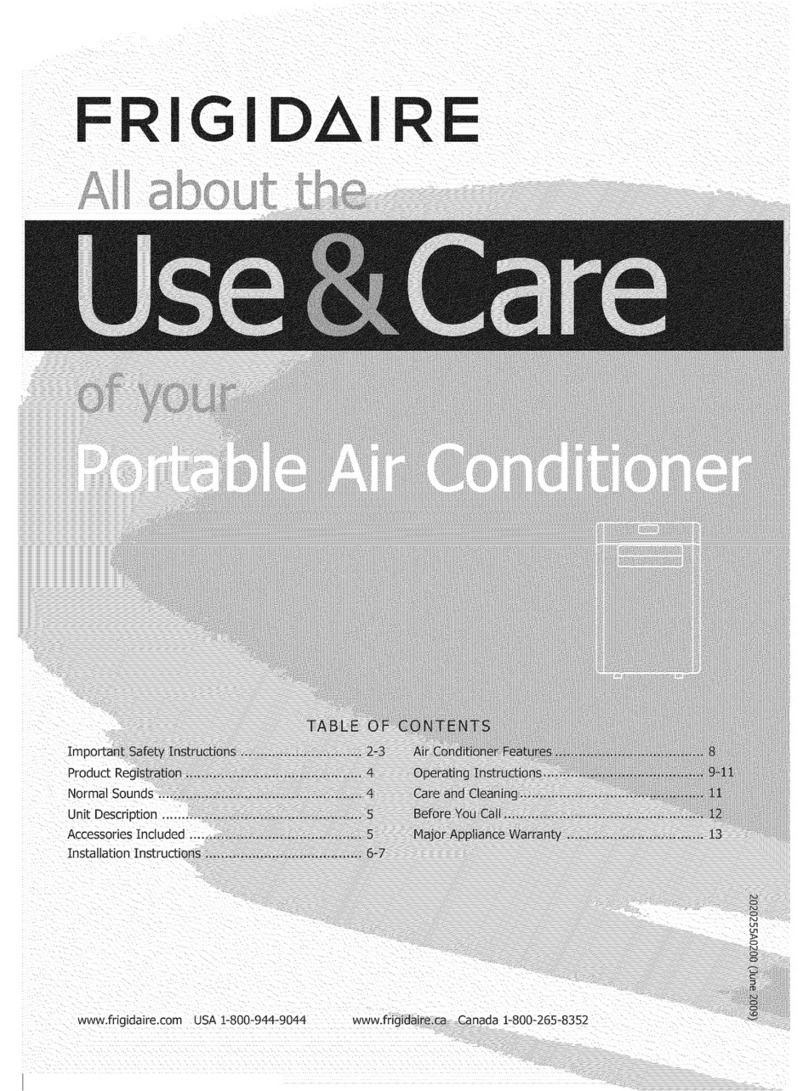
Frigidaire
Frigidaire CRA073PU11 use & care
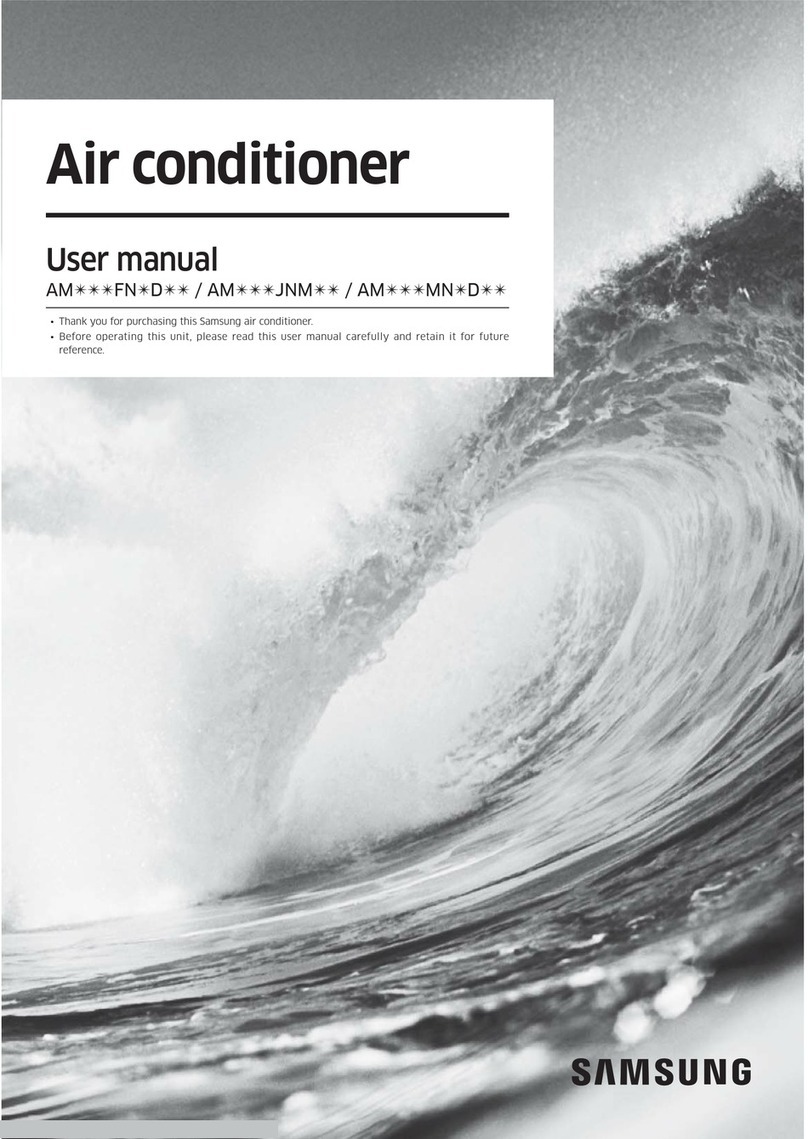
Samsung
Samsung AM***FN*D series user manual

Mitsubishi Electric
Mitsubishi Electric Mr. Slim PUZ-M200YKA2.UK Service manual

York
York DJ 300 Technical guide
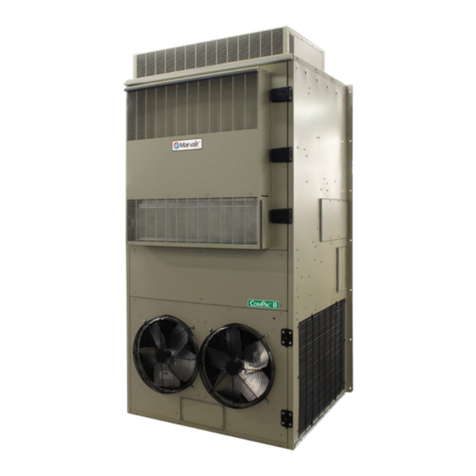
Airxcel
Airxcel Marvair ComPac II AVHDA90 Installation & operation manual
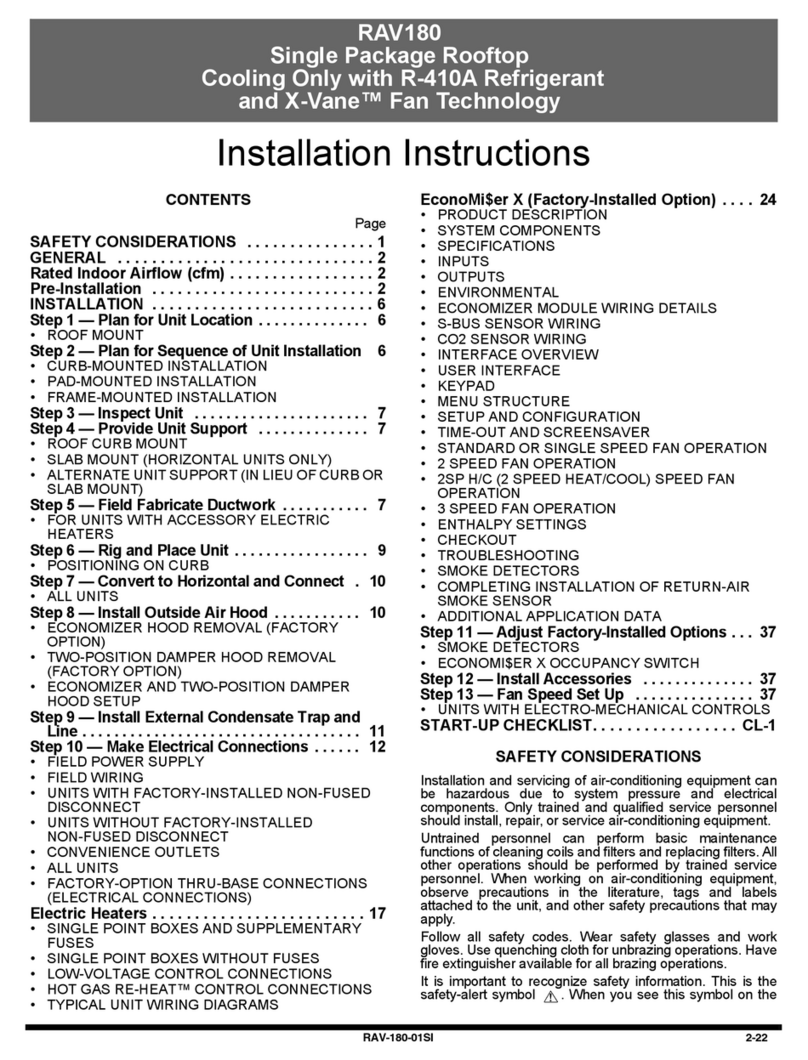
Carrier
Carrier RAV180 installation instructions
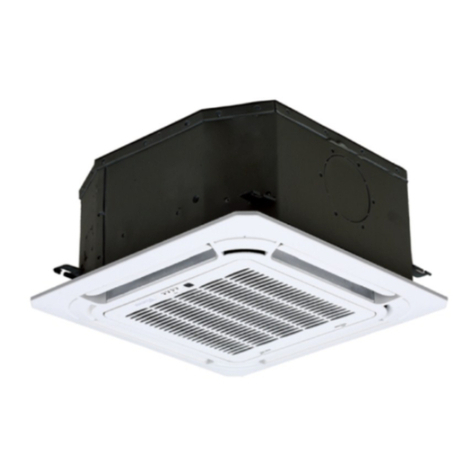
Frigicoll
Frigicoll MKD-V300 Installation & owner's manual
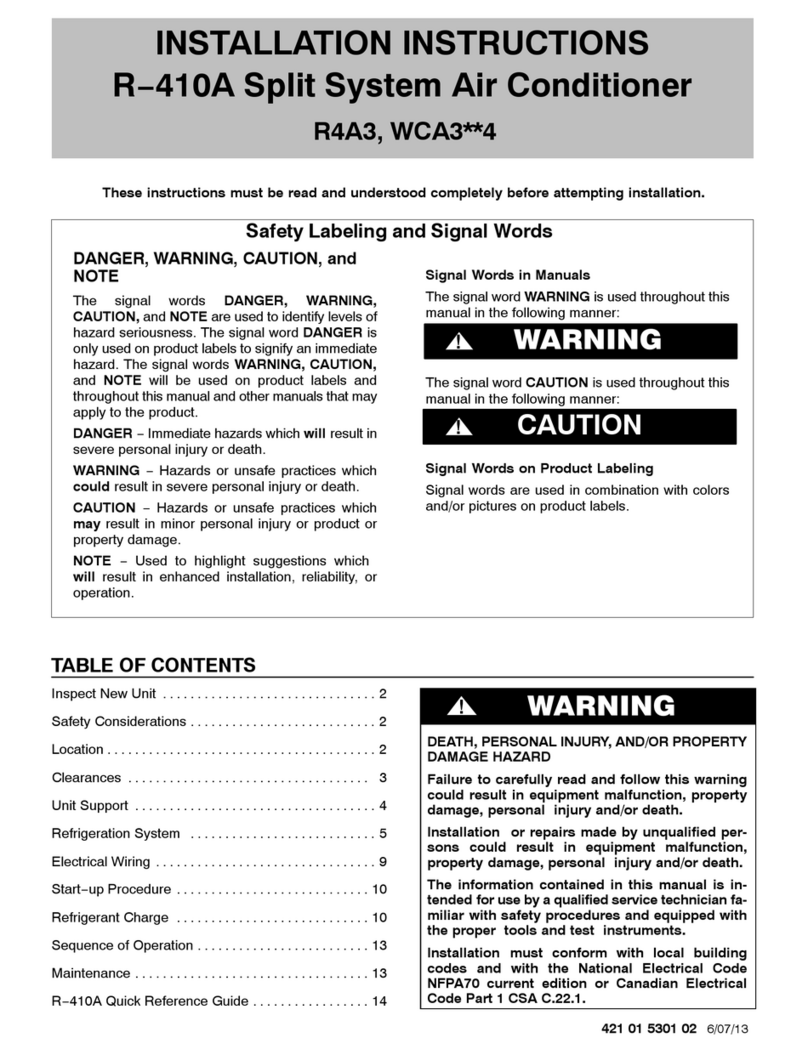
Arcoaire
Arcoaire R4A3 installation instructions
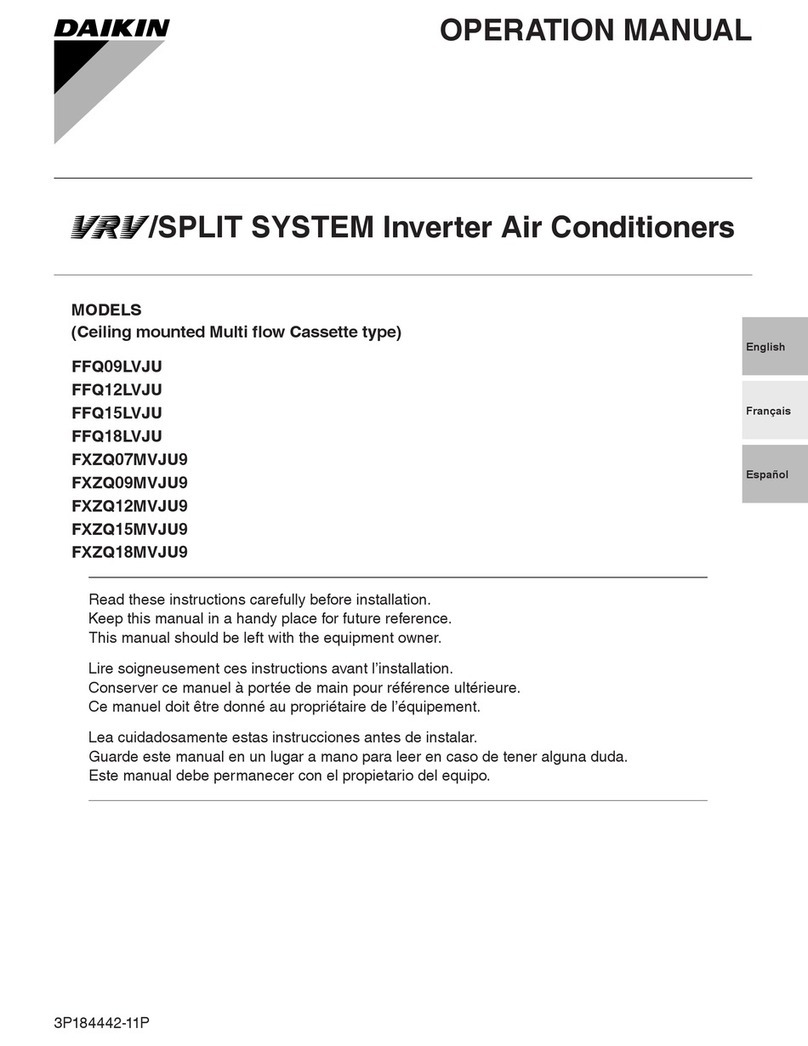
Daikin
Daikin FFQ12LVJU Operation manual

Fujitsu
Fujitsu AGYG09LVCB Service manual
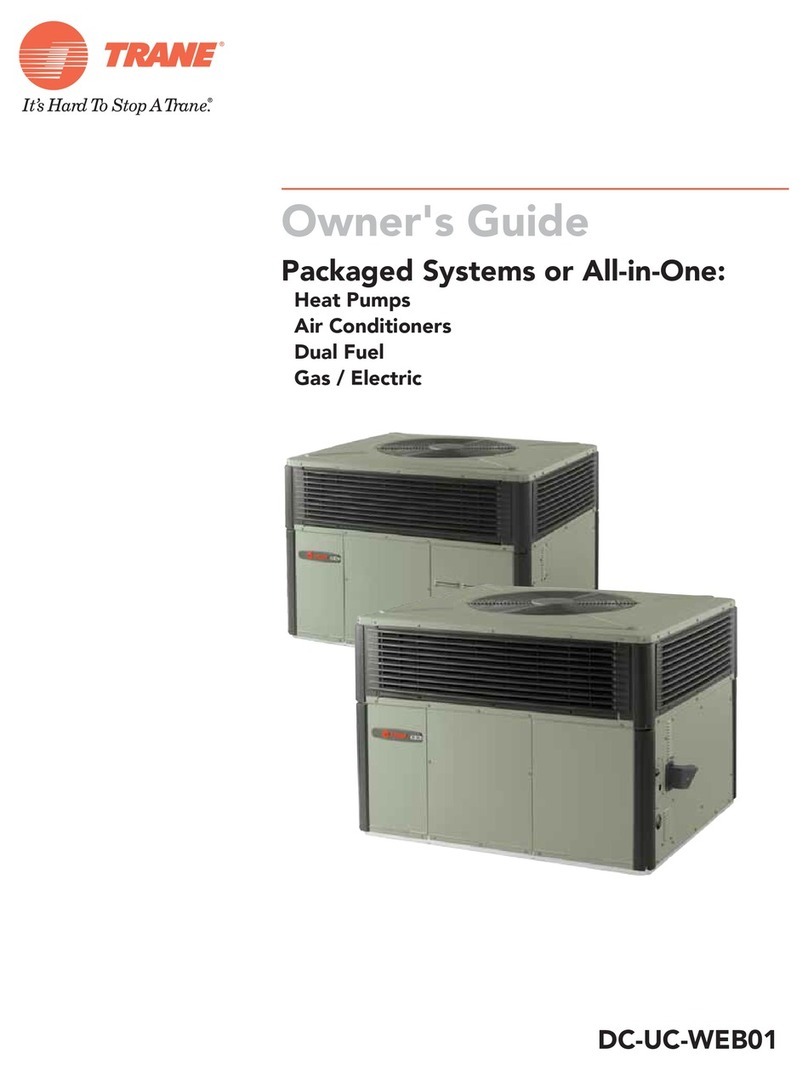
Trane
Trane DC-UC-WEB01 owner's guide
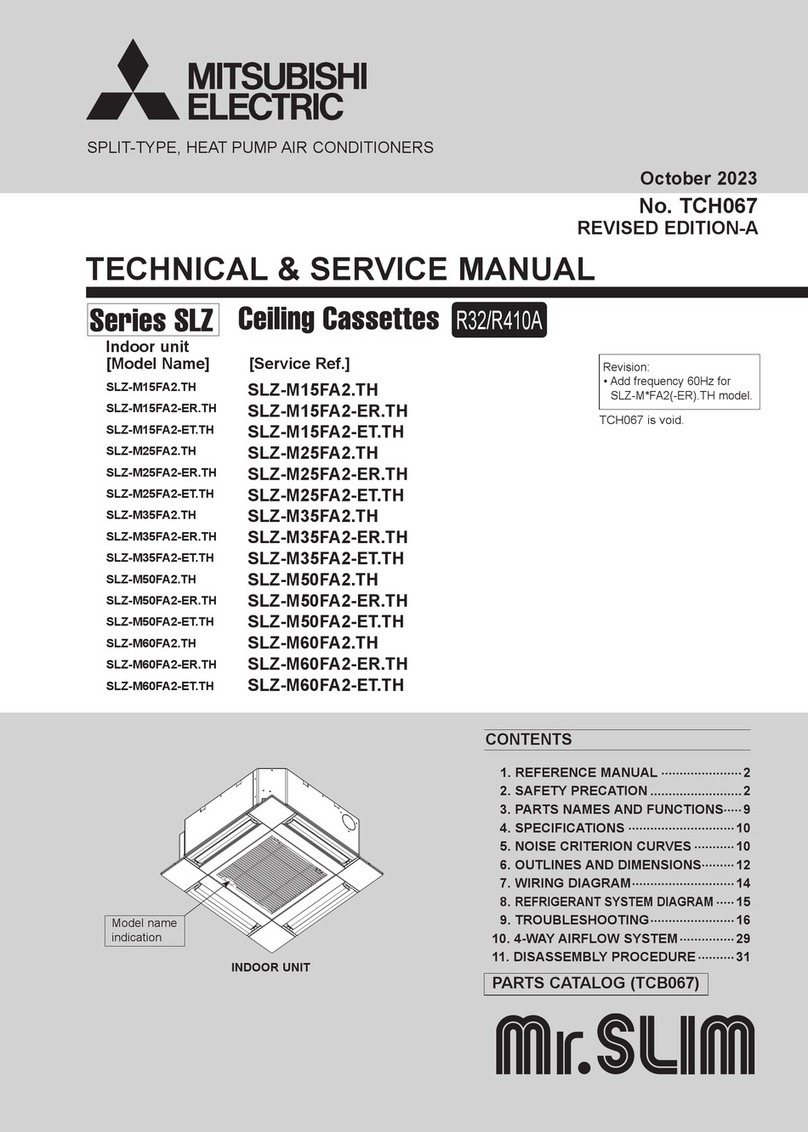
Mitsubishi Electric
Mitsubishi Electric Mr. SLIM SLZ-M15FA2.TH Technical & service manual









